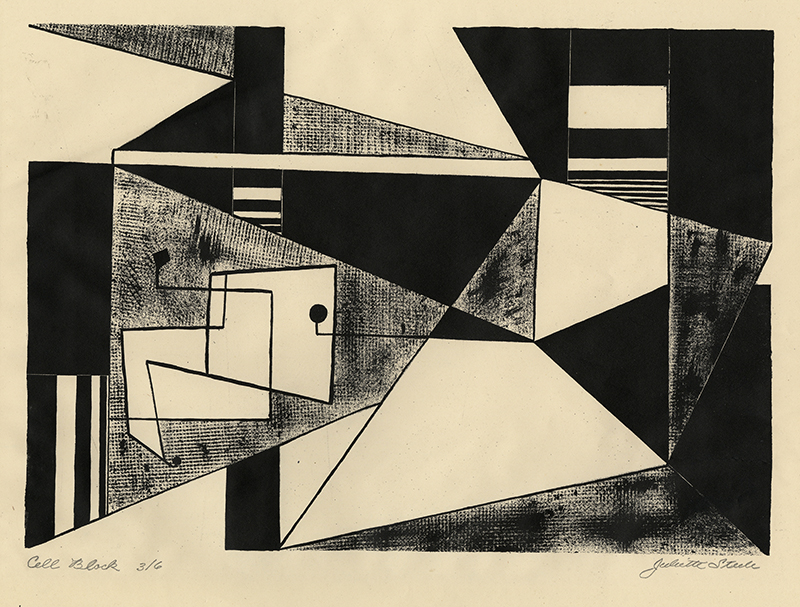Cell Block is a lithograph created about 1948 by American artist Juliette Steele. It is pencil signed, titled, and editioned 3-6. It was printed on cream wove Warren’s Oldestyle watermarked paper and the image measures 9-1/4 x 13" image.
Cell Block is an example of a geometric abstraction that was prevalent 1940s and 1950s. The Museum of Modern Art defines Geometric Abstraction as a form of abstract art the combines geometric, “hard-edge,” or linear forms. Steele seems to have easily moved between styles in the 1940s: her lithographs of San Francisco’s Playland and Fisherman’s Wharf are modernist in their style while others embrace gestural abstraction. Steele’s editions were quite limited as there really wasn’t a ready audience for abstraction or works by Women artists at that time.
Juliette Steele [née Julia Eleanor Wilm], printmaker, painter, and teacher, was born to Otto and Lillian Wilm in Union City, New Jersey on 21 July 1909. She attended the Dickenson High School in Jersey City and then studied art and fashion design at the Traphagen School of Design in New York during the late 1920s. On 23 July 1929, Julia married John Dodig in Manhattan and the couple had a son, Gerald, but later divorced. Julia Wilm Dodig married British born Percy Cyril Edward Steele in Reno, Nevada on 20 June 1944. The couple moved to San Francisco, Julia changed her first name to Juliette, and she enrolled in the San Francisco State College earning her Bachelor of Art degree.
In the 1940s, Steele produced a series of lithographs depicting San Francisco landmarks and she may have printed with Ray Bertrand although no records have been located to definitely link her with the California WPA Federal Art Project. Also in the 1940s, Steele earned her Master of Fine Arts from Stanford University and continued her studies at the California School of Fine Arts in San Francisco where she studied with Ray Bertrand and Clay Spohn. Steele also studied with Stanley William Hayter during the summer of 1948 and learned the process of intaglio printmaking. The following year Steele taught printmaking at the California School of Fine Arts.
Steele first exhibited with the San Francisco Art Association in 1945 and was represented by her lithograph Fisherman’s Wharf in the Ninth Annual Exhibition of Drawings and Prints. Her work was included in the annual exhibitions through 1948 and, for the final year, she exhibited two abstract surrealist lithographs Cyclonic Night and Fire Dance. Steele’s first solo exhibition was mounted at the Artists Guild Gallery in San Francisco in 1947 and the following year an exhibition of her prints was featured at the Weyhe Gallery in New York. The Kharouba Gallery in Seattle presented a solo exhibition of Steele’s paintings and prints in 1949.
Juliette Steele was a member of and exhibited with the San Francisco Art Association, the San Francisco Society of Women Artists, and the Laguna Beach Art Association. She served as president of the San Francisco Society of Women Artists in 1949 and 1950. Juliette Steele’s work is represented in the collections of the National Gallery of Art, Washington, D.C. and the Worcester Art Museum, Massachusetts.
Juliette and Edward Steele were residents of San Rafael, California in the mid 1950s where they operated Steele’s Patio Shop and she raised her sons. Juliette Eleanor Wilm Steele died on 4 March 1980 in San Rafael, California.



